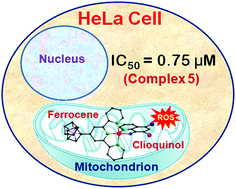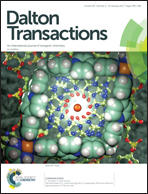Novel mitochondria targeted copper(ii) complexes of ferrocenyl terpyridine and anticancer active 8-hydroxyquinolines showing remarkable cytotoxicity, DNA and protein binding affinity†
Abstract
Metal complexes with organelle specificity and potent but selective cytotoxicity are highly desirable. In this work, we report the synthesis, characterization and cytotoxicity of six novel copper(II) complexes of the formula [Cu(R-tpy)(N-O)]NO3 (1–6), where R-tpy is 4′-phenyl-2,2′:6′,2′′-terpyridine (Ph-tpy; 1–3) or 4′-ferrocenyl-2,2′:6′,2′′-terpyridine (Fc-tpy; 4–6), N-O is the anion of 8-hydroxyquinoline (HQ in 1, 4), 5-chloro-7-iodo-8-hydroxyquinoline (CQ in 2, 5) or 5-nitro-8-hydroxyquinoline (NQ in 3, 6). The complex [Cu(Fc-tpy)2](ClO4)2 (7) has also been prepared as a control and structurally characterized. The optimized geometries and the frontier orbitals of the complexes have been obtained from DFT calculations. The ferrocenyl appended complexes having the anticancer active CQ (in 5) and NQ (in 6) ligands show remarkable cytotoxicity, giving the respective IC50 values of 0.75 μM and 0.52 μM in HeLa and 1.3 μM and 2.6 μM in MCF-7 cancer cells. The phenyl appended complexes 2 and 3 are less active than their ferrocenyl analogues in both the cells while the complexes of HQ (in 1, 4) are the least active. Interestingly, complexes 4–6 are significantly less toxic to MCF-10A normal cells. The DCFDA, annexin-V-FITC and propidium iodide nuclear staining assays reveal an apoptotic mechanism of cell death which is attributable to the metal-assisted generation of reactive oxygen species. Imaging experiments on HeLa cells reveals that complex 5 accumulates primarily inside the mitochondria. The complexes bind to calf thymus DNA with moderate affinity giving Kb values in the range of 6.3 × 104–7.4 × 104 M−1 and to HSA protein with significant affinity giving KHSA values in the range of 8.6 × 104–1.3 × 105 M−1. Their affinity for DNA suggests that mitochondrial DNA could be the target while their affinity for HSA suggests that they could be transported by HSA in the blood. This work is the first report to show that the ferrocenyl appended copper(II) complexes of hydroxyquinoline ligands are remarkably cytotoxic to cancer cells but significantly less toxic to normal cells.



 Please wait while we load your content...
Please wait while we load your content...